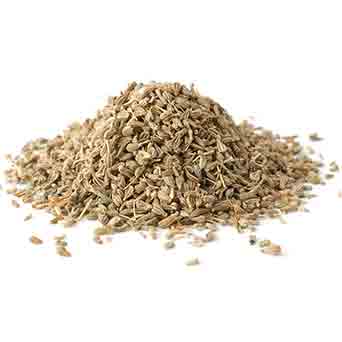Ebani VV, Nardoni S, Bertelloni F, Pistelli L, Mancianti F Molecules, 2018 ABSTRACT: Urinary tract infections are frequently encountered in small animal practice. Escherichia coli and Enterococcus spp. are the most common agents associated to these infections, even though other bacteria and yeasts, such as Candida albicans and Candida famata, may be involved. In view… Read more »

- Botanical Name: Pimpinella anisum
- Alternative Names: Aniseed
- Botanical Family: Apiaceae
- Primary Constituent: Anethole
- Distillation Method: Steam Distillation
- Plant Part: Seed
Toxicities of Selected Essential Oils, Silicone Oils, and Paraffin Oil against the Common Bed Bug (Hemiptera: Cimicidae)
Zha C, Wang C, Li A Journal of Economic Entomology ABSTRACT: The common bed bug [Cimex lectularius L. (Hemiptera: Cimicidae)] and tropical bed bug [Cimex hemipterus F. (Hemiptera: Cimicidae)] resurged in the United States and many other countries over the past decades. The need for safe and effective bed bug control products propelled the development… Read more »
Essential oils of culinary herbs and spices display agonist and antagonist activities at human aryl hydrocarbon receptor AhR
Bartoňková I, Dvořák Z Food Chemistry & Toxicology ABSTRACT: Essential oils (EOs) of culinary herbs and spices are used to flavor, color and preserve foods and drinks. Dietary intake of EOs is significant, deserving an attention of toxicologists. We examined the effects of 31 EOs of culinary herbs and spices on the transcriptional activity of human… Read more »
Antibacterial and Antifungal Activity of Essential Oils against Pathogens Responsible for Otitis Externa in Dogs and Cats
Ebani VV, Nardoni S, Bertelloni F, Najar B, Pistelli L, Mancianti F Medicines (Basel), 2017 ABSTRACT: Background: Essential oils (EOs) are recommended by some veterinarians to treat otitis externa in pets, but data about their efficacy in scientific literature are very scant. Methods:Nine commercial EOs, from roman chamomile (Anthemis nobilis L.), star anise (Illicium verum), lavender (Lavandula hybrida), litsea… Read more »
Synergistic interaction of ten essential oils against Haemonchus contortus in vitro
Katiki LM, Barbieri AME, Araujo RC, Veríssimo CJ, Louvandini H, Ferreira JFS Veterinary Parasitology, 2017 ABSTRACT: Anthelmintic resistance in sheep gastrointestinal nematodes is a worldwide problem. Multi-drug resistant haemonchosis is the most serious impediment for small ruminant systems, and there are no new drug candidates currently under development. Molecules from natural sources have demonstrated anthelmintic… Read more »
Aromatherapy and Essential Oils (PDQ®): Health Professional Version
PDQ Integrative, Alternative, and Complementary Therapies Editorial Board PDQ Cancer Information Summaries, 2017 EXCERPT: This PDQ cancer information summary for health professionals provides comprehensive, peer-reviewed, evidence-based information about the use of aromatherapy and essential oils in the treatment of people with cancer. It is intended as a resource to inform and assist clinicians who care for cancer… Read more »
Antitumor phenylpropanoids found in essential oils
Carvalho AA, Andrade LN, de Sousa ÉB, de Sousa DP Biomed Research International, 2015 ABSTRACT: The search for new bioactive substances with anticancer activity and the understanding of their mechanisms of action are high-priorities in the research effort toward more effective treatments for cancer. The phenylpropanoids are natural products found in many aromatic and medicinal… Read more »
The potential effectiveness of essential oils as a treatment for headlice, Pediculus humanus capitis
Veal L
Complementary Therapies in Nursing and Midwifery, 1996
The palliation of nausea in hospice and palliative care patients with essential oils of Pimpinella anisum (aniseed), Foeniculum vulgare var. dulce (sweet fennel), Anthemis nobilis (Roman chamomile) and Mentha x piperita (peppermint)
Gilligan NP
International Journal of Aromatherapy, 2005
Repellency of cassia bark, eucalyptus, and star anise oils and their major constituents to Leptotrombidium pallidum (Acari: Trombiculidae)
Shin EH, Song BG, Lee IH, Park MY, Ahn YJ, Chang KS
Journal of Medical Entomology, 2013
